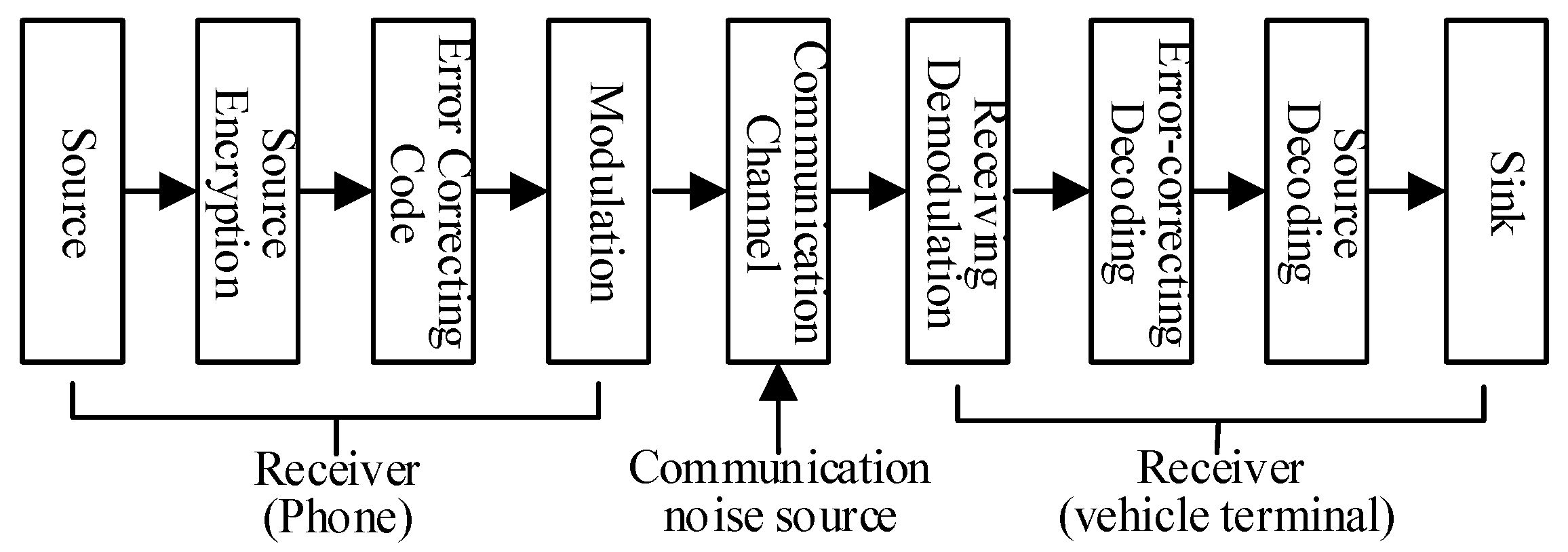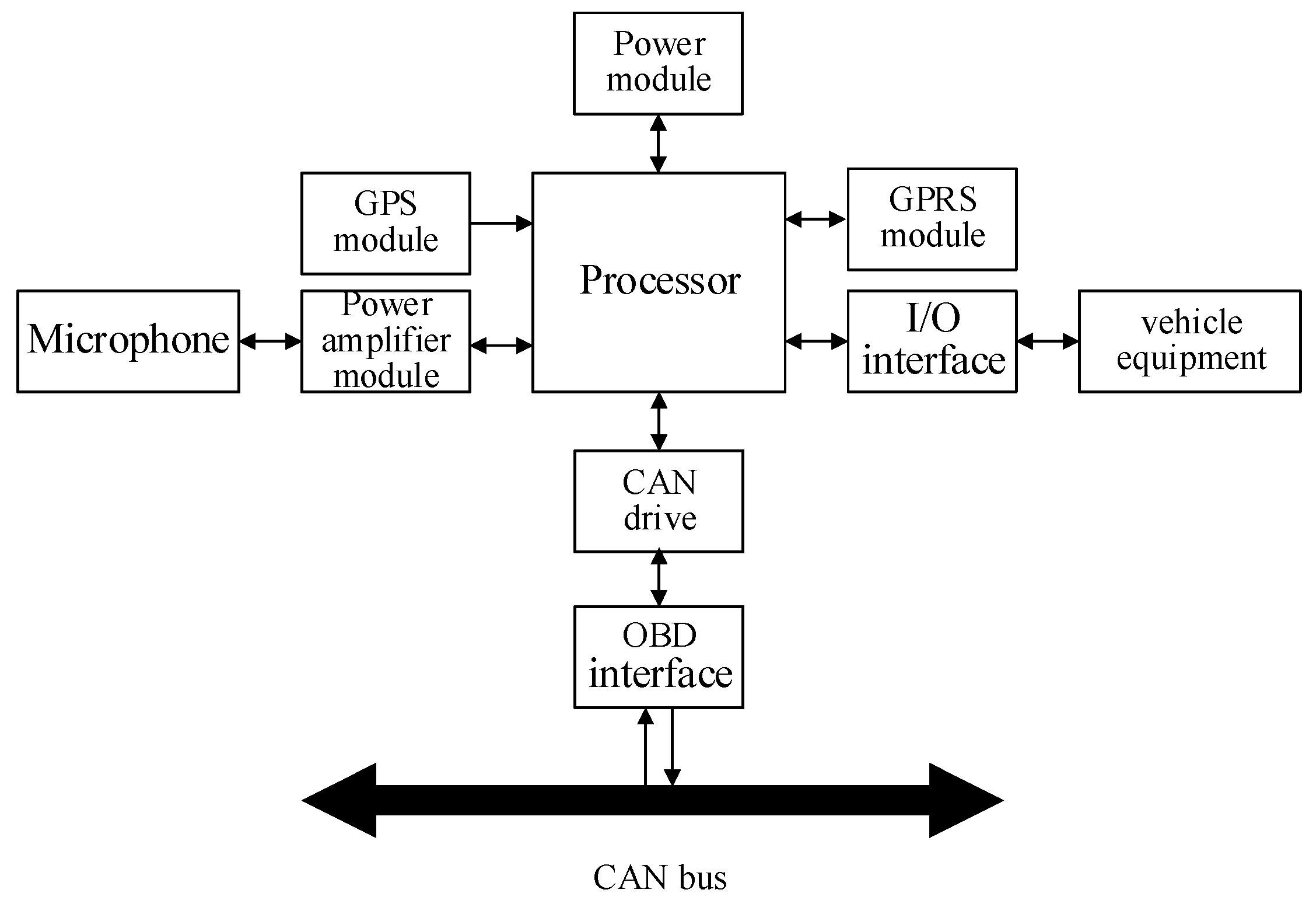1. Introduction
The electric vehicles become more and more important in the future [
1,
2,
3,
4,
5], with the increasing of the environmental awareness in the energy consumption area [
6]. With the promotion of electric vehicles, the time-sharing rental business model with the electric vehicles as its carrier is developing rapidly. Vehicle terminal, as an intermediary of management platform and electric vehicle, is the only way to achieve remote monitoring, which is the main execution of the whole time-sharing business process for electric vehicles. The remote control is the main function of the vehicle terminal, supporting the time-sharing rental business process of electric vehicles. The responding speed affects the sense of user experience directly [
7].
At present, in order to reduce the cost of communication, GPRS wireless communication is still mainly used on electric vehicle terminal to exchange data with management platform in real time. However, in the weak signal area, the response time of the electric vehicle terminal will become much longer, which has a great influence on the controlling of the management platform and the experience of users. In order to solve this problem, the main approach is to apply near-field communication [
8,
9] such as Bluetooth [
10,
11,
12], radio frequency identification/near-field communication (NFC/RFID) [
13,
14] in vehicle terminal, leading to a balance and control between Bluetooth, NFC/RFID GPS, and global system for mobile communications (GSM), which may help to achieve goals of automatic identification, data acquisition and transmission, and remote real-time monitoring [
15,
16,
17,
18]. However, Bluetooth communication has the compatibility problem of APP development. The credit card payment method as NFC, RFID needs to increase the cost and management of card and other issues. It is urgent to develop a near field communication mode with stronger compatibility, lower cost and more convenient management to realize the fast response of vehicle terminal.
Acoustic wave communication is a kind of near field communication mode, which transmits information by acoustic wave [
19]. However, the study of acoustic communication started late, the related technology rarely reported, mainly concentrated on the field of underwater acoustic communications [
20,
21,
22,
23]. In 1945, the first underwater acoustic communication system was developed by the US Navy’s underwater acoustic laboratory, which was mainly used for communication between submarines. Since the 70s of last century, with the development of electronic technology and information science, underwater acoustic communication technology has been switched from analog modulation technology [
24] to digital modulation technology [
25]. The acoustic field of the Chinese Academy of Sciences has studied the propagation of acoustic signals in the shallow sea, the adaptive matching experiment of marine acoustic channel, and the underwater communication experiment is carried out by using channel estimation and error correction code [
26]. Harbin Engineering University has designed methods like frequency hopping, multi frequency, multi frequency and phase modulation mixing, adaptive discrete cosine transform (DCT) compression, vector quantization, and artificial neural network compression. Xiamen University uses multi-frequency shift keying (MFSK) to modulate the transmitted signal and detects the signal with the fast fourier transform (FFT) method [
27]. Currently, the Institute of Acoustics of the Chinese Academy of Sciences, Northwestern Polytechnic University, Harbin Institute of Technology, Xiamen University, and other research institutions carried out research on underwater acoustic communication [
28,
29], which promoted the acoustic communication to be an effective near field communication technology.
At present, acoustic communication has become a popular way to realize near-field payment and control by virtue of good development compatibility, low cost, high degree of integration with mobile phone, and fast response. On the market, acoustic communications technology has been successfully integrated into intelligent devices. Overseas mainly has two acoustic wave communication products, which belong to Chirp and Zoosh. In China, the development of acoustic communication technology is mainly based on Alibaba, which is used in the face-to-face payment function, and has not been applied to vehicle terminals. In order to solve the problems of poor compatibility, high cost, and complicated operation in traditional near field communication, it is necessary to introduce acoustic communication technology to develop a new type of time-sharing rental vehicle terminal for electric vehicles.
This paper introduces the basic principle of acoustic communication, from the overall framework, decoding module, acoustic noise reduction algorithm, control flow, and other aspects of the novel vehicle terminal. The content of effective distance and anti-noise performance indicators were tested by second chronograph to verify the performance of the novel vehicle terminal based on acoustic communication technology for the time-sharing rental electric vehicles comparing with the traditional GPRS communication technology in the same situations.
5. Application
In order to verify the rapid response capability of vehicle terminal for time-sharing rental electric vehicle based on acoustic communication technology, the vehicle terminal (recorded as A car) without the acoustic communication technology and the vehicle terminal (recorded as B car) with the acoustic communication technology are placed in the same weak signal area, such as the underground garage, to compare their response time and effectiveness.
Two electric vehicles are parked in two underground parking garages for testing respectively, one of the underground parking garage is an F1 building in a business district, the other one is an F1 building in a community. The GPRS intensity of two places is tested by using R&S’s network signal special test instrument. After testing, the GPRS signal strength of two parking garages was −90 dBm and −104 dBm. According to the device description of the signal number and the level of the received level of the contrast relationship (show as in
Table 5), the GPRS signal strength of F1 building in a business district was relatively good, but not sufficient. The GPRS signal strength of F1 building in a community was weak, but the GPRS signal was basically covered.
In this environment, mobile phones were used in two parking garages on the electric car electronic lock to carry out five times the unlocking and locking operation and record the response time by the second chronograph. The specific statistical results are shown in
Table 6 and
Table 7.
It can be seen from
Table 6 and
Table 7 that the acoustic communication technology could realize the rapid response of the vehicle terminal, which effectively solved the problem of prolonged and slow response in the vehicle terminal of the electric vehicle in weak signal area.















